





The elegance of an attractive houseplant combined with easy care is what we all want. The following popular specimens are handsome foliage plants that are also low-maintenance and rewarding for anyone to grow.
#1 Heartleaf Philodendron (Philodendron scandens ssp. oxycardium)
In narrowing down the list of which plants to include in "Five Easy Houseplants and How to Grow Them", I keep returning to the winsome Heartleaf Philodendron to place at the top of my list. What's not to love? The heart-shaped leaves are like green valentines, loving you back. It's an adorable, easy, low-maintenance specimen.
Beginners gravitate to the Heartleaf because it's cute and satiny and has a vining habit—it trails. What fun it is to get the vine started around a window frame or some other support and then watch!
It is rewarding to discover how obliging this specimen is. The worst thing that could happen might be overkill in full sun at the hand of the uninitiated. Or perhaps death by either drowning or dehydration. Do not place Heartleaf in the same window or light source as you would your high-light plants like cacti and succulents. It does not require full sun. Place it in filtered light or in the shade of a light-loving plant indoors.
My heartleaf specimen lives in filtered sun; it sits on an upside-down wooden box in the shade of a Purple Velvet plant (Guynura aurantiatica). 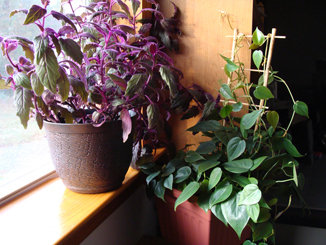 Although this is in my big southern-facing window, the Guynura protects the Heartleaf from getting burned. If I move the Guynura, the Heartleaf must move, too. All-day southern exposure through a glass window is a bit too much for a philodendron.
Although this is in my big southern-facing window, the Guynura protects the Heartleaf from getting burned. If I move the Guynura, the Heartleaf must move, too. All-day southern exposure through a glass window is a bit too much for a philodendron.
Heartleaf loves to be misted and watered as needed. The finger test is best. Dig your finger down into its soil. Do you feel moisture? Does the soil cling to your finger? Then don't water it yet; wait a few days. But if you wait too long (like when the soil is bone-dry), the leaves will curl and the satin sheen will disappear. Give it water when it is thirsty, but not every day. Its roots need to breathe a little. Once you get used to having this philodendron, you will know at a glance if it needs water or not.
My heartleaf especially appreciates it when I take it into the bathroom for a day because it thrives on the extra humidity from the shower stall whenever the shower is in use.
In addition, once or twice a month, I group several large pots of indoor plants together on the floor of the shower stall, draw the curtain, and let the shower spray a misty lukewarm drink on them. (Some folks let the water go for fifteen minutes or more.) Watch the water; be careful that it does not get too warm. You can leave the plants inside the closed shower stall for a few hours afterward. Let them soak up every drop of humidity they can get. Then take them out of the bathroom and into the light. If you are lucky enough to have light suitable for houseplants and enough room in your bathroom, then by all means, let the philodendrons live there! I think they will be very appreciative of that moist environment.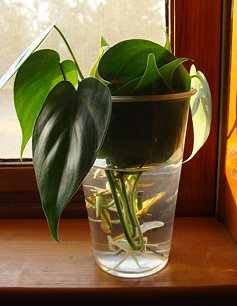
Heartleaf propagates easily via stem cuttings placed in a jar of water. Be sure to include a joint when you cut. Remove the lower leaves of the cutting. Place in a small jar in medium light. Before long, you will see roots growing from the joints in the water jar. Take the cuttings out and plant them in a small pot of potting soil. I use orchid soil (with lots of little pieces of bark) mixed with a bit of sphagnum peat and vermiculite. Water well so that water flows from the generous drainage holes that I hope are in the bottom of your planter pot.
So now you have reproduced your Heartleaf Philodendron plant! That's the beauty of stem cuttings: You get more plants to keep your specimens going and to share as well. Finally, feed your Heartleaf at half the strength called for with any general all-purpose plant food about twice a month, and you will have a loving specimen for years to come.
#2 Golden Pothos (Epipremnum aureum)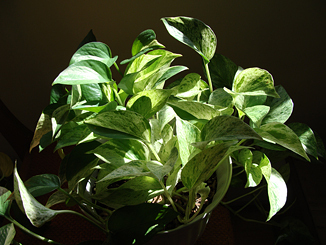
Similar to the Philodendron in its vining habits and light requirements, the Golden Pothos gets the number two spot on my list of easy houseplants. Some folks refer to the Pothos as a Philodendron, but that is not accurate. It is an Epipremnum, native to the Solomon Islands.
I like the Golden Pothos for the splashes of yellow or white on its glossy leaves that never cease to surprise me as they unfurl. On the same plant, some of the leaves might be green while other leaves might be an even split, half green and half yellow/white. Still other leaves on the same plant can be royally marbled. It all depends on how each leaf is programmed. This photo shows the "Marble Queen" variety, marbled in white.
Pothos, like the Philodendron, loves to have something to climb. A bonus for this plant would be a mossy or woody support for it to cling to. These are available at home improvement stores and garden centers or could be fashioned at home using wire, wood, and moss. However, if making a support for your climbing plants is not an option, the plant is just as pretty with its trailing vines that add drama to a balcony, stairway, or any place needing a splash of color. It will look just as pleasing without the support whether in the home or office. Let those vines dangle, as long as they are not in the way of anything. On the contrary, the Pothos will be a conversation piece as it thrives under a fluorescent office light.
Light requirements are similar to those of the Philodendron, except the Pothos can take a bit more light. Do not place it in direct light, or it will suffer sunburn. Many houseplants that originate in the tropics are used to growing under the canopy of trees found in the rain forest, so direct light would be a bit much for them. Fluorescent light works well for the Pothos. If you have a source of that, whether ordinary fluorescent light tubes or special plant tubes, place your Pothos there and see how lovely it will grow.
Pothos can be propogated with stem cuttings just like the Philodendron. One thing to watch for might be rot if this is done in the winter. Pothos seems to be a bit more prone to suffer rot than a Philodendron if the cuttings sit in water on a cold windowsill. Placed under an ordinary table lamp, a jar of cuttings or a newly-potted young pothos might get a better start due to the warmth.
Feed the Pothos as you would your Philodendron, and you will reap the rewards of a dramatic, easy plant for a long time.
#3 Snake Plant (Sansevieria trifasciata)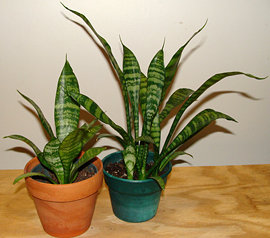
Here's another easy plant with pretty markings: 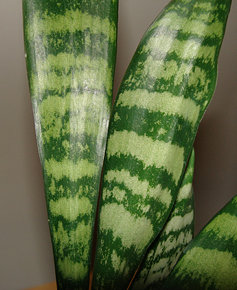 The Snake Plant, or Mother-in-Law's Tongue. Maybe it should be #1 since this plant is practically indestructible. It's the best plant to get for the person who wants to fill in a lonely spot in the house or office but who knows nothing about plants. Tell them it's a no-fuss, impossible-to-kill plant. But that doesn't mean they don't ever have to water it or give it light.
The Snake Plant, or Mother-in-Law's Tongue. Maybe it should be #1 since this plant is practically indestructible. It's the best plant to get for the person who wants to fill in a lonely spot in the house or office but who knows nothing about plants. Tell them it's a no-fuss, impossible-to-kill plant. But that doesn't mean they don't ever have to water it or give it light.
The Snake Plant is somewhat of a low-light plant that enjoys an occasional splash of light by taking it out of its low-light spot (such as in a north or east window) and putting it in a brighter place (such as a west window) for a day. As with the previous two plants described, full sun is too much for it.
However, I have seen snake plants in all sorts of undesirable conditions that still thrived. The snake plant is a survivor; that's what makes it an easy houseplant. The margin of error is very big for this plant. I've only ever witnessed the demise of a snake plant once, and that was due to the owner NEVER watering it.
When watering the snake plant, be sure that the pot has excellent drainage. Although I have grown these plants in clay pots, I prefer sturdy plastic so that the snake does not stay dry constantly. Keep the fertilizer to a minimum. Keep the light on the low side (but don't leave it in the dark), and your snake plant will grow into a beautiful specimen that you will be proud of.
Propagation of snake plants is easiest by dividing the spears that grow up from the roots, making sure that each piece you pull off has some root attached. For a challenge, you could propagate your snake via one-inch stem cuttings as described in my article, Plant Rescue. I don't recommend beginners trying to propagate a snake plant. Let them begin by being proud of their ability to keep their first plant alive and thriving.
To learn more about the snake plant, read Introduction of Sansevierias, one of the premiere houseplants available by Geoff Stein.
#4 Wandering Jew (Tradescantia zebrina)
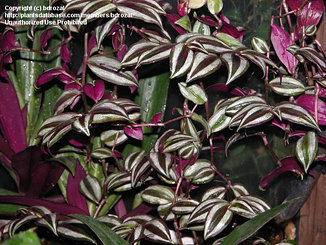 An easier plant to care for and love cannot be found except those already listed. The Wandering Jew practically takes care of itself without any help from you at all. (Well, almost.) As a houseplant, you need only give it soil, and it will take off like a rocket. A little water at the right time, some gentle light (not high light, not low light) coming in from a window, and I promise you, you will be pinching, trimming, propagating, and giving away Wandering Jew cuttings for decades.
An easier plant to care for and love cannot be found except those already listed. The Wandering Jew practically takes care of itself without any help from you at all. (Well, almost.) As a houseplant, you need only give it soil, and it will take off like a rocket. A little water at the right time, some gentle light (not high light, not low light) coming in from a window, and I promise you, you will be pinching, trimming, propagating, and giving away Wandering Jew cuttings for decades.
The great part about Wandering Jew is that it comes in many colors. When you get tired of having just one type, you can trade with friends (try Dave's Garden for trading!) or shop for a different variety. I recently purchased a striped tradescantia to go along with my purple-striped variety that lived outdoors this past season. Outside, it grew as a hanging plant in the shade of a mimosa tree. It even began to grow directly in the ground at the base of the mimosa after a few pieces fell out of the pot! But now it is time to bring that purple Wandering Jew back inside.
Wandering Jew is related to the Commelinas, a family of plants that look similar, grow aggressively, and flower in the same way. Outdoors, commelinas can be invasive. Indoors, they are perfectly manageable as houseplants, limited by the indoor environment.
Like the Philodendron and the Pothos, Wandering Jew can be used as a trailing accent in your home or office. It will need to be trimmed and pinched for bushier growth, but that effort is so worth it for the beauty of the tradescantia's form and color. The purple is breathtaking when grouped with green plants.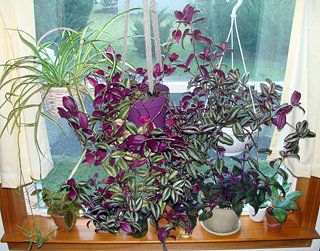
I like to keep Wandering Jew cuttings going all the time. This is easily done in the same manner as with the Philodendron and Pothos, but quicker! You will see roots almost immediately. Making plants from existing plants is fun to do especially as Christmas draws near. What a great gift to give: the gift of a living thing. Wandering Jew, with its slivery leaves, goes well with Christmas. Keep in mind that while some folks would appreciate a living plant, others would find it a burden, so give wisely.
#5 Spider Plant (Chlorophytum comosum)
The good ol' Spider Plant is a tried and true easy plant for beginners and non-beginners alike. I first became aware of this plant way back in the 80's and thought it looked like an interesting clump of grass with funny things growing out of it. A gardening friend gave me a closer look at her spider plant to see how the stalks emerge from among the leaves with a baby plant on the end of each stalk. I was hooked when she generously clipped a few ripe "babies" and instructed me to place them on the top of a pot of plant soil. Spider plants and I are fast friends.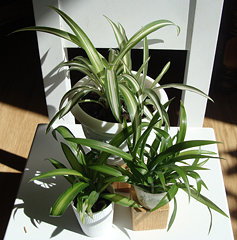
Related to the lily, spider plants grow grassy and put out tiny, lily-shaped flowers along with the stalks and baby plants.
To propagate the spider plant, cut a baby or two off about one inch from the join where the "stick" meets the juvenile plant. Place the cut baby on top of moist potting soil. Sometimes the babies will need to be anchored with anything in the shape of an upside down "U", gently pushed down on top of the little plant to hold it in contact with the soil. You can bend a twist-tie for this purpose or straighten a paper clip and cut it to fit. Even a bobby pin works in a pinch. Stretch the bobby pin into a wide "V" shape, and you're good to go with an emergency anchor.
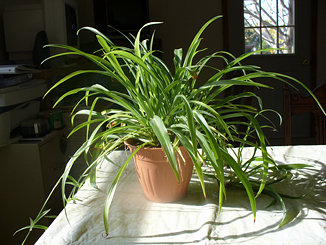 Spider plants come in different varieties. I started with the green variety and gravitated to the variegated types, particularly enjoying the reverse variegated spider. Dave's Garden has a Marketplace where you can find varieties of spider plant to purchase, or you may trade with others using the Plant Trading Discussion Forum (where there are friends you haven't yet met) who are willing to exchange specimens.
Spider plants come in different varieties. I started with the green variety and gravitated to the variegated types, particularly enjoying the reverse variegated spider. Dave's Garden has a Marketplace where you can find varieties of spider plant to purchase, or you may trade with others using the Plant Trading Discussion Forum (where there are friends you haven't yet met) who are willing to exchange specimens.
Spiders have one special need that landed them in the number five spot, and that is their sensitivity to salt build-up in their soil. To learn more, a good place to find out about spider plant care can be located in the Beginner Houseplants Discussion Forum. To be safe, feed very sparingly and water well to allow any salts to drain away. It is better to have a slightly dry spider on your hands than an overly-wet one, I believe. So make sure that your spider lives in well-draining soil in a well-draining pot, and you will not have problems.
Copyright © www.100flowers.win Botanic Garden All Rights Reserved